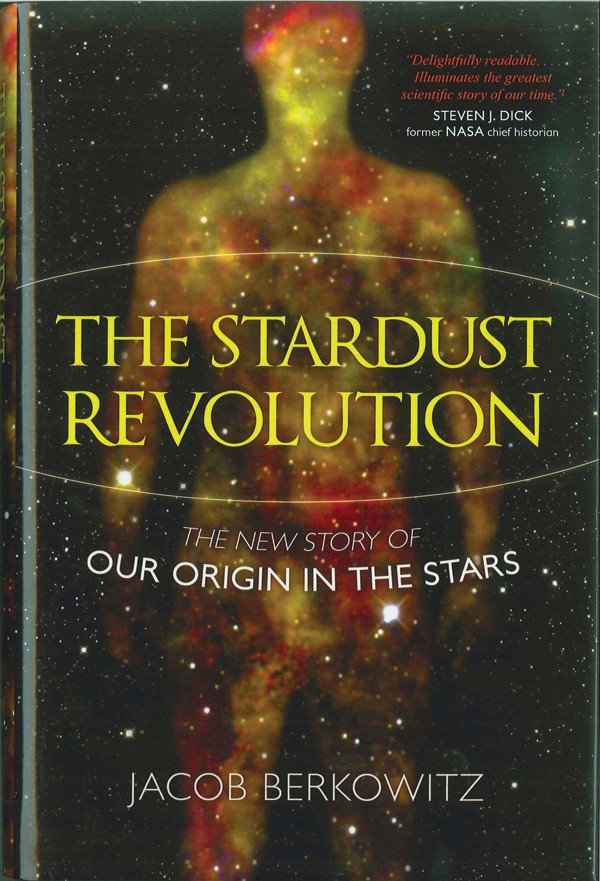
by Jacob Haqq-Misra Sunday, January 4, 2015

"The Stardust Revolution: The New Story of Our Origin in the Stars," by Jacob Berkowitz, Prometheus Books, 2012, 9781616145491.
In the 1980 television show “Cosmos,” astronomer Carl Sagan famously noted: “The nitrogen in our DNA, the calcium in our teeth, the iron in our blood, the carbon in our apple pies were made in the interiors of collapsing stars. We are made of starstuff.” This scientifically and philosophically profound concept — that we are starstuff through and through — has been known for less than 50 years, and the history of its discovery was fraught with naysayers.
Today, the notions that all the elements of the universe were forged in the fiery furnaces of stars, and that organic molecules exist in space, are considered textbook knowledge. How that came to be is the subject of Jacob Berkowitz’s book, “The Stardust Revolution: The New Story of Our Origin in the Stars.”
Berkowitz takes the reader on a journey that begins with the first stars that formed after the Big Bang. These first stars contained only hydrogen and helium, but the process of nuclear fusion gradually generated the elements in the periodic table numbering up to iron — and the dramatic core collapses of dying massive stars fused iron into the rest of the naturally occurring elements (ranging up to uranium) as these stars exploded as supernovae. This process, known as nucleosynthesis, is the primary focus of Berkowitz’s book, as it provides a theme linking astronomy, chemistry and biology.
Berkowitz highlights the interdisciplinary collaborations needed to understand nucleosynthesis and how these forces led to the establishment of astrobiology and astrochemistry. Astronomer “planet hunters” also contribute to the extension of biology into space by looking for potentially habitable planets orbiting other stars — a possibility once thought confined to the realm of science fiction. Berkowitz is keen to identify times in the recent past when now well-established ideas were thought to be impossible — a common theme throughout the book.
Berkowitz’s history is colored with characters who bring the process of science to life. Interwoven with descriptions of spectroscopy, nucleosynthesis and radio astronomy are individual perspectives and nearly forgotten anecdotes that exemplify the humanity of the scientists who often overcame tremendous personal struggles in order to pursue their passion for scientific knowledge.
One example comes from the difficulties faced by astronomer Margaret Burbidge (who later became the first female president of the American Astronomical Society) in gaining access to the telescopes on Mount Wilson near Pasadena, Calif. In 1955, observatory policy stated that “two things weren’t allowed: whiskey (in fact, all alcohol) and women,” Berkowitz writes. In order to collect crucial observations that would help to establish stars as the birthplace of elements, Burbidge first had to agree to reside in separate quarters and avoid men outside her team — all while hiding the fact that she was pregnant.
Although the narrative draws out at times, the combination of personal history and scientific exposition — one of the book’s strengths — successfully illustrates how incremental steps contribute to the “big picture” in science.
Overall, the book provides a unique historical approach to the emergence of astrobiology that should be digestible for a wide range of audiences. The book is ideal for science enthusiasts already familiar with some of the major concepts in astronomy, and scientists will appreciate the careful interviews and personal stories.
The book concludes with a philosophical discussion about the possibility of life on other worlds. If we truly are made of stardust, along with our planet and everything else, and if organic molecules really are plentiful in space, then it is possible that somewhere in the vast universe is another inhabited planet with its own biology and ecosystems. In closing, Berkowitz reviews the methods that future scientists might use to identify planets that aren’t just habitable, but are actually inhabited.
© 2008-2021. All rights reserved. Any copying, redistribution or retransmission of any of the contents of this service without the expressed written permission of the American Geosciences Institute is expressly prohibited. Click here for all copyright requests.